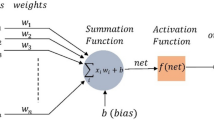Abstract
A number of researchers headed by E. Gardner have proved that a maximum achievable memory load of binary perceptron is 2. A learning algorithm allowing reaching and even exceeding the critical load was proposed. The algorithm was reduced to solving the linear programming problem. The proposed algorithm is sequel to Krauth and Mezard ideas. The algorithm makes it possible to construct networks storage capacity and noise stability of which are comparable to those of Krauth and Mezard algorithm. However suggested modification of the algorithm outperforms.
Access this chapter
Tax calculation will be finalised at checkout
Purchases are for personal use only
Preview
Unable to display preview. Download preview PDF.
Similar content being viewed by others
References
Karandashev, I., Kryzhanovsky, B., Litinskii, L.: Hopfield-type memory without catastrophic forgetting. In: Future Computing 2011: The Third International Conference on Future Computational Technologies and Applications, pp. 57–61. IARIA (2011)
Gardner, E., Derrida, B.: Optimal storage properties of neural network models. J. Phys. A: Math. Gen. 21, 271–284 (1988)
Hertz, J., Krogh, A., Palmer, R.: Introduction to the Theory of Neural Computation. Addison-Wesley, Massachusetts (1991)
Kryzhanovsky, B.V., Kryzhanovsky, V.M.: Binary Optimization: On the Probability of a Local Minimum Detection in Random Search. In: Rutkowski, L., Tadeusiewicz, R., Zadeh, L.A., Zurada, J.M. (eds.) ICAISC 2008. LNCS (LNAI), vol. 5097, pp. 89–100. Springer, Heidelberg (2008)
Krauth, W., Mezard, M.: Learning algorithms with optimal stability in neural networks. J. Phys. A: Math. Gen. 20, L745–L752 (1987)
Author information
Authors and Affiliations
Editor information
Editors and Affiliations
Rights and permissions
Copyright information
© 2012 Springer-Verlag Berlin Heidelberg
About this paper
Cite this paper
Kryzhanovskiy, V., Zhelavskaya, I., Karandashev, J. (2012). Binary Perceptron Learning Algorithm Using Simplex-Method. In: Rutkowski, L., Korytkowski, M., Scherer, R., Tadeusiewicz, R., Zadeh, L.A., Zurada, J.M. (eds) Artificial Intelligence and Soft Computing. ICAISC 2012. Lecture Notes in Computer Science(), vol 7267. Springer, Berlin, Heidelberg. https://doi.org/10.1007/978-3-642-29347-4_13
Download citation
DOI: https://doi.org/10.1007/978-3-642-29347-4_13
Publisher Name: Springer, Berlin, Heidelberg
Print ISBN: 978-3-642-29346-7
Online ISBN: 978-3-642-29347-4
eBook Packages: Computer ScienceComputer Science (R0)




